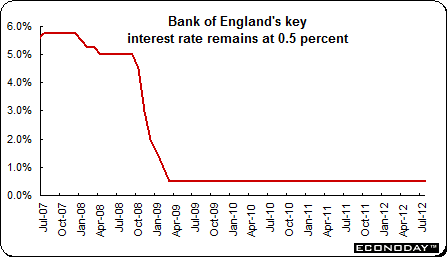The Bank of England acquired interest rate setting powers in 1998. In May 1997, the then newly appointed Chancellor of the Exchequer, Gordon Brown, announced that the labor government was giving the Bank of England operational responsibility for setting interest rates. The Bank of England Act of 1998 was implemented on June 1st, 1998. Control of monetary policy now resides with the Bank of England in its Monetary Policy Committee (MPC).
The Committee is composed of the Governor, two Deputy Governors, two Bank Executive Directors, and four experts appointed by the Chancellor. The MPC meets monthly (usually the first Wednesday and Thursday of the month) to determine interest rate policy. Unlike the Federal Reserve or the European Central Bank, the Bank of England has an established fixed inflation target of 2.0 percent. Mervyn King replaced Sir Edward George as governor on July 1, 2003.
The Bank of England’s primary goal is to contain inflation and it uses an inflation target to do so. Beginning with the January 2004 meeting, the Monetary Policy Committee is using the harmonized index of consumer prices for its inflation indicator and is called the CPI. Previously, the MPC used the retail price index excluding mortgage interest payments as its inflation indicator and a 2.5 percent inflation target. There has been a substantial spread between the two measures of inflation which can be traced to the way they are calculated. Among the key differences is the exclusion of council taxes and owner-occupied housing costs from the CPI. Arithmetic means are used to combine individual prices to construct the RPIX while geometric means that allow for substitution are used in calculation of the CPI. This formula differential accounts for nearly half of the difference in the two rates.
Interest rate decisions are announced immediately after their meetings. The meeting's minutes, including a record of any vote, are normally published two weeks following the meeting. The Bank is not entirely free from the Exchequer, but is assigned an inflation target in the Chancellor of the Exchequer's budget message.

The Bank's monetary policy objective is to deliver price stability (as defined by the Government's inflation target) and, without prejudice to that objective, to support the Government's economic policy, including its objectives for growth and employment. The Government's inflation target is confirmed in each Budget statement. The Bank publishes a quarterly Inflation Report, which spells out the Bank's forecasts and the thinking of committee members. Needless to say, market participants closely scrutinize the report.
The Bank of England had been waging an aggressive campaign against consumer price inflation and had pushed their key interest rate to 5.75 percent. And until the credit crunch, more interest rate increases were anticipated to quell inflation. However, the credit crunch, subprime mess and sinking growth have forced the BoE to change direction. The Monetary Policy Committee lowered the key interest rate by 25 basis points at both the January and February 2008 meetings and then again in April. However, given inflationary pressures, MPC members kept their key interest rate unchanged at 5 percent. The BoE lowered the key interest rate on October 8, 2008 in the coordinated rate reduction with other central banks including the Federal Reserve, the ECB and the Bank of Canada among others.
Since October 2008, the Bank has chopped 400 basis points from the key rate, reaching a low of 0.5 percent in March 2009 where it has remained. MPC members cut their policy rate by 150 basis points in November and another 100 basis points in December of 2008. When the interest rate reached 2 percent, the Bank was at the lowest level since 1951 and at the same time, equaled its lowest rate since the Bank was founded in 1694.
The BoE adopted quantitative easing in order to lower interest rates by flooding the market with funds through the purchase of gilts — government bonds. The initial goal was to purchase £75 billion, but at the May meeting, the amount was increased to £125 billion, to £175 billion in August and £200 billion in November 2009. At its October 2011 meeting, the MPC increased the program’s ceiling to £275 billion. It increased its ceiling to £325 billion in February, 2012 and again in July by £50 billion to £375 billion.
|